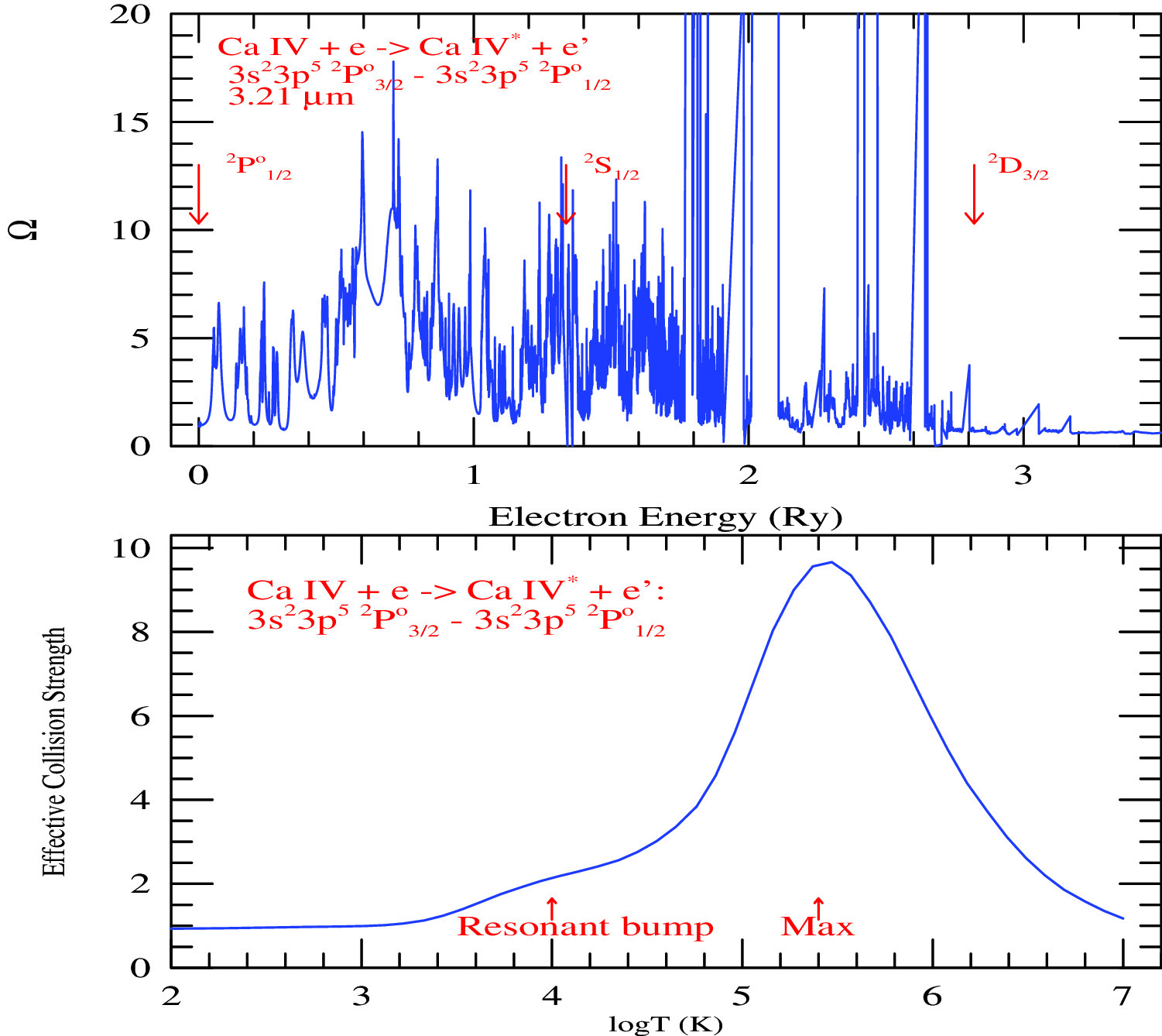https://doi.org/10.1140/epjd/s10053-023-00622-8
Regular Article – Atomic and Molecular Collisions
Collisional excitation and photoexcitation of Ca IV including a strong 3.2  m emission line
m emission line
1
Astronomy Department, The Ohio State University, 140 W. 18th Ave, 43210, Columbus, OH, USA
2
Physics Department, University of Azad Jammu and Kashmir, 13100, Muzzafarabad, Kashmir, Pakistan
Received:
22
October
2022
Accepted:
20
February
2023
Published online:
20
March
2023
Graphic Abstract: We report a detailed study of features of electron impact excitation (EIE) of Ca IV (Ca IV + e  Ca IV* +
Ca IV* +  Ca IV + h
Ca IV + h ), for the first time using the relativistic Breit–Pauli R-matrix method with a large close-coupling wave function expansion of 54 fine structure levels belonging to
), for the first time using the relativistic Breit–Pauli R-matrix method with a large close-coupling wave function expansion of 54 fine structure levels belonging to  complexes. Calcium lines in the infrared (IR) region are expected to be observed by the high-resolution James Webb Space Telescope. Our study predicts the presence of a strong 3.2
complexes. Calcium lines in the infrared (IR) region are expected to be observed by the high-resolution James Webb Space Telescope. Our study predicts the presence of a strong 3.2  m emission line in IR formed due to EIE of
m emission line in IR formed due to EIE of  in Ca IV. The EIE collision strength (
in Ca IV. The EIE collision strength ( ) for the transition shows extensive resonance with enhanced background (top panel, Figure below), resulting in an effective collision strength (
) for the transition shows extensive resonance with enhanced background (top panel, Figure below), resulting in an effective collision strength ( ) of 2.2 at about 10
) of 2.2 at about 10 K that increases to 9.66 around 3
K that increases to 9.66 around 3 k (lower panel, Figure below). The present results include
k (lower panel, Figure below). The present results include  for all 1431 excitations among the 54 levels and
for all 1431 excitations among the 54 levels and  for a limited number of transitions of possible interest. We found extensive resonances in the low-energy region of
for a limited number of transitions of possible interest. We found extensive resonances in the low-energy region of  , and convergence of the resonances and of the partial waves with the 54-level wave function. At high energy,
, and convergence of the resonances and of the partial waves with the 54-level wave function. At high energy,  decreases beyond the resonance region for forbidden transitions and is almost constant or decreases slowly for dipole-allowed transitions with low oscillation strength (f-values) and increases with Coulomb–Bethe behavior of ln(E) to almost a plateau for transitions with high f-values. The wave function of Ca IV was obtained from optimization of 13 configurations
decreases beyond the resonance region for forbidden transitions and is almost constant or decreases slowly for dipole-allowed transitions with low oscillation strength (f-values) and increases with Coulomb–Bethe behavior of ln(E) to almost a plateau for transitions with high f-values. The wave function of Ca IV was obtained from optimization of 13 configurations  , each with the core configuration of
, each with the core configuration of  , using the SUPERSTRUCTURE atomic structure program. They produce 387 fine structure levels. We report transition parameters—oscillator strength, line strength (S) and A-values-for a total of 93,296 electric dipole (E1), quadrupole (E2), octupole (E3), magnetic dipole (M1) and quadrupole (M2) transitions among these levels. The lifetimes of these levels are also presented.
, using the SUPERSTRUCTURE atomic structure program. They produce 387 fine structure levels. We report transition parameters—oscillator strength, line strength (S) and A-values-for a total of 93,296 electric dipole (E1), quadrupole (E2), octupole (E3), magnetic dipole (M1) and quadrupole (M2) transitions among these levels. The lifetimes of these levels are also presented.
Sultana Nahar and Bilal Shafique have contributed equally to this work.
Copyright comment Springer Nature or its licensor (e.g. a society or other partner) holds exclusive rights to this article under a publishing agreement with the author(s) or other rightsholder(s); author self-archiving of the accepted manuscript version of this article is solely governed by the terms of such publishing agreement and applicable law.
© The Author(s), under exclusive licence to EDP Sciences, SIF and Springer-Verlag GmbH Germany, part of Springer Nature 2023. Springer Nature or its licensor (e.g. a society or other partner) holds exclusive rights to this article under a publishing agreement with the author(s) or other rightsholder(s); author self-archiving of the accepted manuscript version of this article is solely governed by the terms of such publishing agreement and applicable law.





